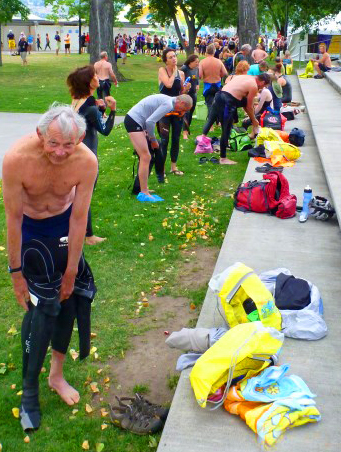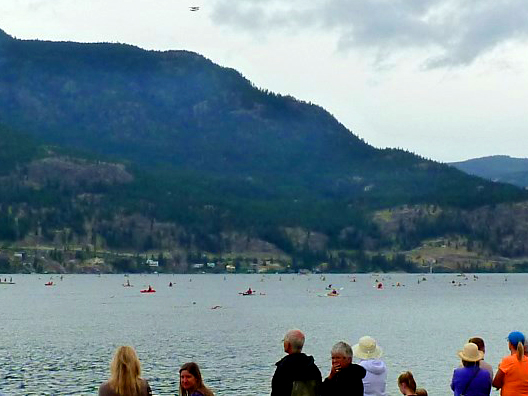We see neither wind nor wave from our perch on some rocks above the start of the 66th Across The Lake Swim, which loosely parallels the William R. Bennett Bridge (or Kelowna Floating Bridge), from the Old Ferry Wharf in West Kelowna to Hot Sands Beach, City Park, Kelowna in British Columbia’s arid interior.
‘Any wind? Any waves?’
‘Nope. You’re in for a smooth swim.’ 
Support craft have traversed the old ferry crossing, ready to meet up with their swimmers, and we ask the same question of each—a canoeist, a kayaker, and a stand-up paddle boarder. All concur that neither wind nor wave are a factor.
And yet, why does the water feel so cool? Much cooler than the 21-degree lake water we’ve enjoyed this past week. We defer our warm-up swim until minutes before the in-water start. That’s enough time to get a lubricating H2O layer in our wetsuits. The start is imminent, and the starter reviews sighting strategies.
‘Look for the mountain’s distinctive notches,’ he says. ‘And then the grove of trees, and finally the arc of balloons marking Hot Sands Beach.’ It’s a linear A-to-B swim. A cinch?
Nine waves of a hundred swimmers per wave gather together like birds readying for migration. I’m in wave four, the yellow caps, behind the blue caps, dark green caps, and red caps. Behind me, the orange, pink, green and glow yellow and orange caps congregate. We’ll take off at two-minute intervals. We’re swimming with others of similar ability, like birds of a feather.
As I wait, I spot a boy I met on the bus-ride over, who is a first-time ATLS swimmer. He tells me he’s pulling out.
‘I only weigh 85 pounds,’ he says. ‘I might get hypothermic without a wetsuit.’ I congratulate this pre-teen for his wisdom. He’s water-safety aware.
All grade three children from Peachland to Lake Country receive free swim lessons from the YMCA thanks to an ATLS initiative to reinvest sponsorship dollars. Prevention and awareness are drowning antidotes, and this young man’s got good judgment in spades. It’s not his day and he’s not too proud to admit it. Another day—another year.
The only waves are us as we walk along the shoreline on a ribbon of tender-toe-friendly carpet, and as I wade in, I silently commend the boy’s decision. My two-millimeter wetsuit protects me from the chill, as well as an additional fifty pounds of flesh. The water’s cooled since yesterday. Still do-able, I tell myself… once we get going.
Each wave gets the go-ahead countdown— ‘5-4-3-2-1-GO’— and we’re off. The first 500 meters, I acclimatize to water temperature— a merger of internal and external forces. Internal ones are my immediate energy from Mamma Rosa’s spaghetti plate last night, and energy stores from training swims in the months leading up to this event. Positive self-talk says, ‘Yes, I can. Can do, can do, can do…’
External ones are how this lake’s colour, temperature and body (of water) feel to me now. I’m sighting on those very mountain notches, then the tree grove and finish line that the announcer aforementioned. It’s like swimming in a green smoky-sediment of cool broth, with little patches of lukewarm broth spooned in. I’m relaxed and on my own, with the occasional swimmer stroking surreally into my field of view.
I’m not sure at what point I realize that the sight line progression from notches to grove to finish balloons are not transitioning as quickly nor as smoothly as usual. When I reach the third sight marker, the finish arc of balloons, something seems awry.
I’m swimming along the shoreline for the final 200 meters, and either the arc has skewed sideways, or I have. ‘Strange,’ my left brain whispers, but my right brain is so full of spatial angles, it’s not until I get out and walk down to the shoreline that I see it. My first sensation is fatigue. My second is shock. 
I scan across the lake for fellow swimmers and see no one. And yet, to my right, as far as the eye can see, they’re stretched in a giant letter ‘U’.
As I watch, I listen to the finish line announcer say there’s a north-flowing current taking swimmers down the lake…way down. They’re doubling or tripling their distance, and subsequently, their time in the water.
The Okanagan Valley watersheds drain into the north, central and southern basins and flow south through arid ecosystems— south through Okanagan River, Skaha Lake, Osoyoos Lake into Washington State, the Columbia River system, finally ending their freshwater flow from Portland, Oregon, into the Pacific Ocean.
This 135-kilometer lake has a southward flow, so the image before me just doesn’t compute. Swimmers drifting north. Is it wind-driven? The pontoon bridge blocks wind to some extent. Maybe a northerly surged through the archway like a flood-tide, bringing cool water with it.
I await my husband on the shore and wonder if he’s okay. I wait for an hour. That’s double what I would normally wait. I’ve nearly doubled my own time. Everything seems a ½-hour delayed, yet the reassuring voice from the finish line, and the presence of so many water safety professionals tell me it’s best to wait. Stay put.
Later on, he tells me a young lifeguard paddled over to him, while he’d stopped to tread water and massage a calf-muscle cramp, to ask if he was okay. Eventually, they mutually agree that a power-boat ride back seems the most reasonable outcome. He witnesses several other pickups, and tells me how professional the volunteer lifeguards are. How reasonable. How persuasively rationale with several hundred swimmers.
‘Do you think you’re making headway? No?’
‘Do you realize you still have another two kilometers to go? Double your distance? No?’
‘Might you like to get in the powerboat? Yes?’
I’ve swum this event over ten times since 1988, and my husband, since 1990, and we’ve never felt so well-taken-care-of. From Friday’s check-in, race-package pickup and orientation, race packet swag bag, towel ‘n’ t-shirt, goodies, Saturday check-in and gear-check, bus transport to the start, Rotary Club pancake breakfast and coffee, Save-On-Foods-donated bananas and cookies along with sponsor and vendor tents. But most of all to the race director, Peter Rudd, safety director, Randall Wight, the First Aid & Lifeguards, and the whole ATLS team, thank you, for another super-safe ATLS.
Back in the 5th century BCE, Greek philosopher, Herodotus, admired the Persian (mounted) Postal Service:
‘Neither snow, nor rain, nor heat, nor gloom of night stays these courageous couriers from the swift completion of their appointed rounds.’ Many have quoted it since, including the US Postal Service.
But the same may be said for the ATLS organizers:
‘Neither wind, nor wave stays these courageous couriers (lifeguards & organizers) from helping us Across The Lake Swim.’
**Thanks to a communique from ATLS, it turns out the swim wasn’t a cinch, but a Seiche underwater wave, a wind-induced phenomena, which blew us north, but will hopefully appease Ogopogo, Salish for lake demon, for years to come.**